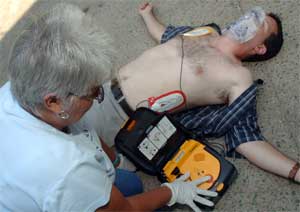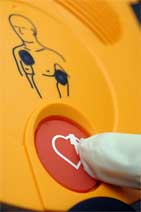 |
| Pauline Jones and Stephen Ellis, posing as a heart-attack victim, demonstrate the use of an automated external defibrillator. Â (Abriel photo) |
A number of new lifesaving devices are popping up across HÂþ», and the Environmental Health and Safety Office hopes theyÃll soon be as familiar as fire extinguishers.Â
The Safety Office is installing a series of Automated External Defibrillators (AEDs) in campus lobbies and well-travelled areas, so theyÃre easy to find in a crisis. Dal already had three à in Dalplex and two safety patrol cars. Five more were recently installed, with plans for at least 10 more over the next year.
ÃIf someoneÃs heart stops beating properly, an AED could start it again,â says Health and Safety Officer Stephen Ellis. ÃIf a person goes into sudden cardiac arrest, you Ãzapà them and hopefully restore a normal hearth rhythm. Without defibrillation, the chance of survival is virtually zero per cent.â
The rapidly aging population à as baby boomers move into their senior years à means the equipment is taking on greater significance across the continent. While DalÃs students donÃt need to worry too much about sudden cardiac arrest, the precaution makes sense with the number of faculty and staff over age 40, as well as conference attendees and audiences at concerts, lectures and other public events.
ÃThe Rebecca Cohn Auditorium is a prime example of a place where youÃd definitely want one. There are 1,000 people there most nights,â says Mr. Ellis, adding the HÂþ» Arts Centre is now equipped.
The portable defibrillators are designed so anyone can use them. Training is provided by the Health and Safety Office but itÃs not a requirement to operate the AEDs, since the devices give detailed voice prompts to guide rescuers.
ÃItÃs basically no harder to operate than a fire extinguisher, and we want them to be reasonably accessible,â says Mr. Ellis. Knowledge of CPR is very helpful, he adds, because it is used in conjunction with the AEDs for an even better chance of survival.Â
Most of DalÃs defibrillators are mounted on walls in white cabinets, with an illustrated instruction chart posted nearby. Inside the cabinet is the AED as well as a black bag equipped with disposable gloves, a breathing mask, scissors and a razor (so rescuers can shave small patches on patients with very hairy chests).
When to use an AED
When the AED lid is opened, voice prompts will guide the next steps. The device analyzes the heart rhythms and then tells the operator whether to administer a shock. If defibrillation occurs within four to six minutes of the cardiac arrest, it can restore normal heart rhythm. ÃItÃs very likely that these devices are going to be legislated for public places over the next 10 years anyway. So weÃre being proactive and making sure theyÃre available in case of emergency,â says Mr. Ellis, encouraging all departments to contact the Safety Office if theyÃd like to discuss having one installed.  ÃItÃs a life or death issue,â he says. ÃYou donÃt really think about it until you need it. And thereÃs no point in having one five kilometers away. When you need it, you need it quickly.â |

